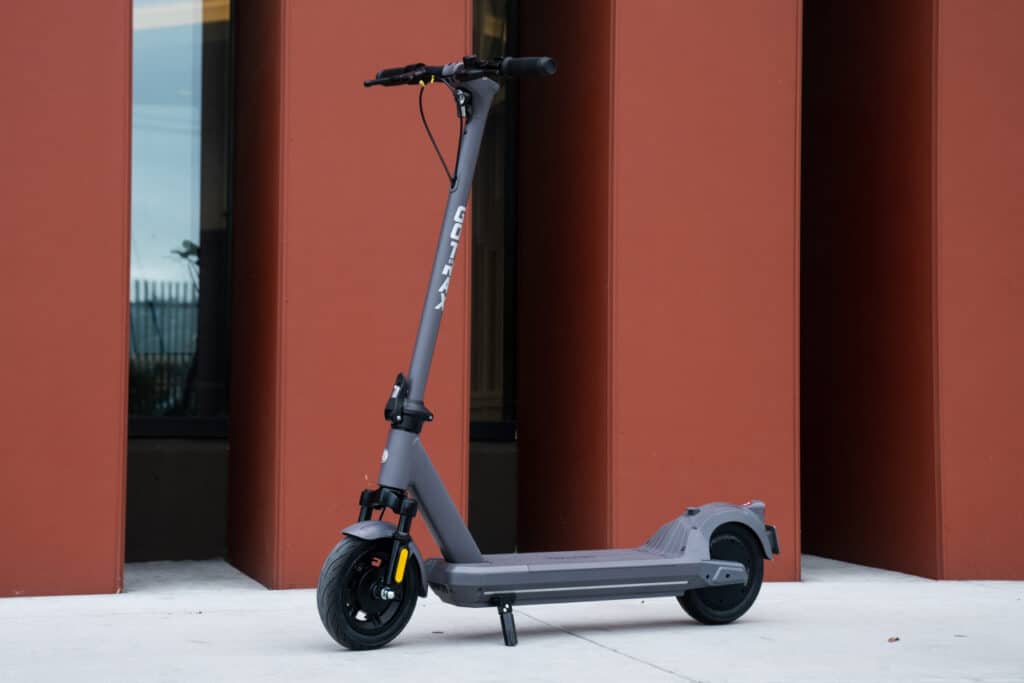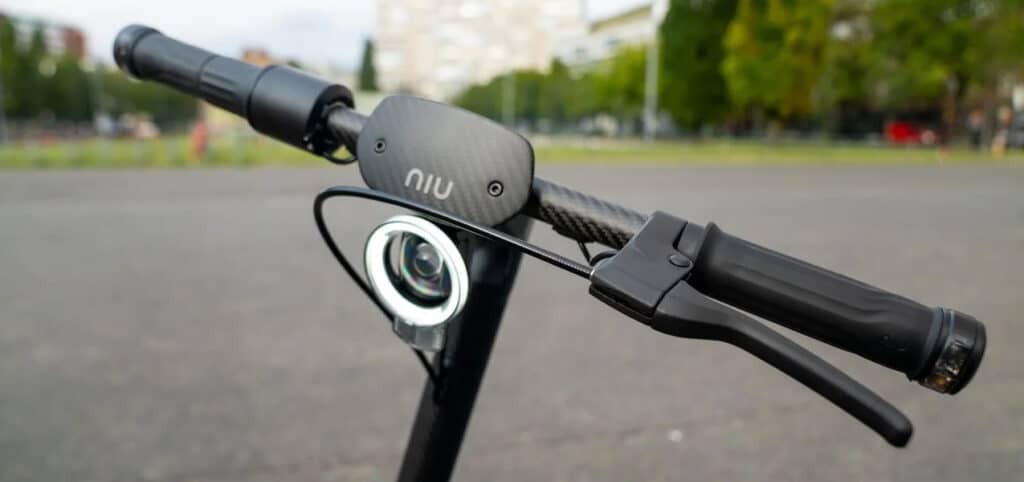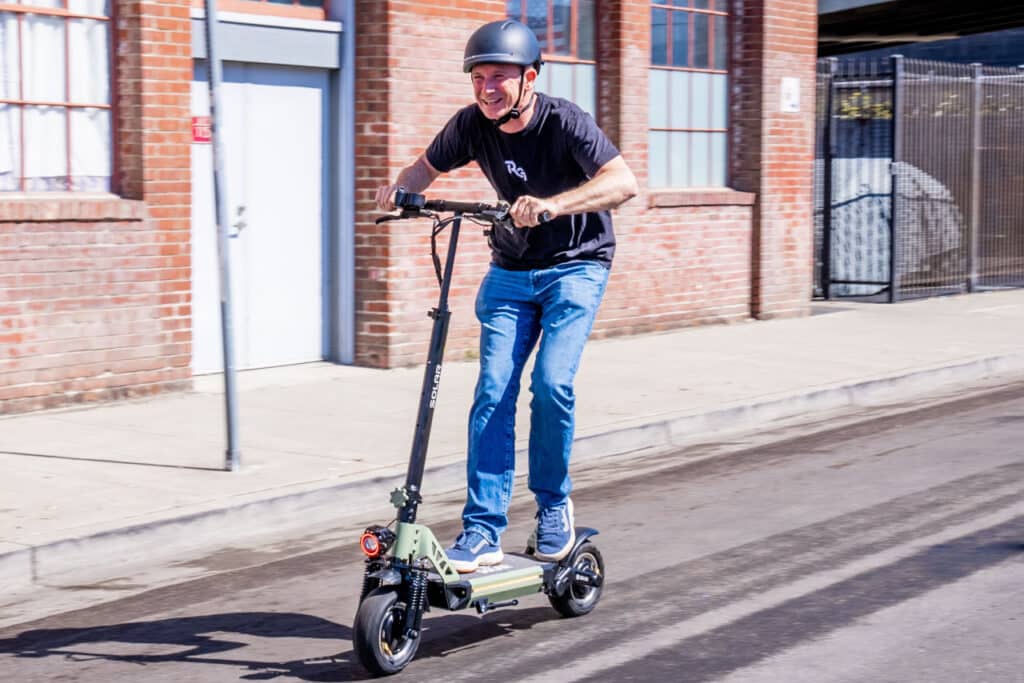M365 Pro - $599

Paul Somerville
April 18, 2020
Rider Guide’s Editor-in-Chief is a seasoned expert in the electric scooter industry. With a wide-ranging background that includes managing scooter warehouses, selling thousands of motorcycles, and restoring high value (+1M) European sports cars, his expertise is unmatched. Having personally tested more than 100 electric scooters, he offers invaluable insights and recommendations to our readers. We are fortunate to have him as part of our team, as his diverse skill set and extensive experience ensure top-notch reviews.
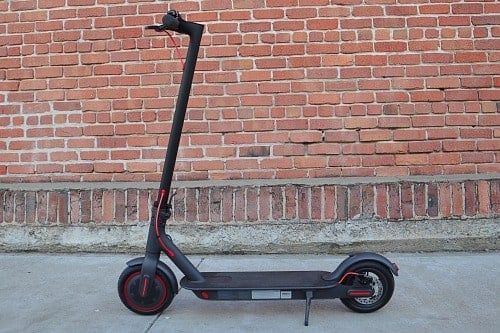
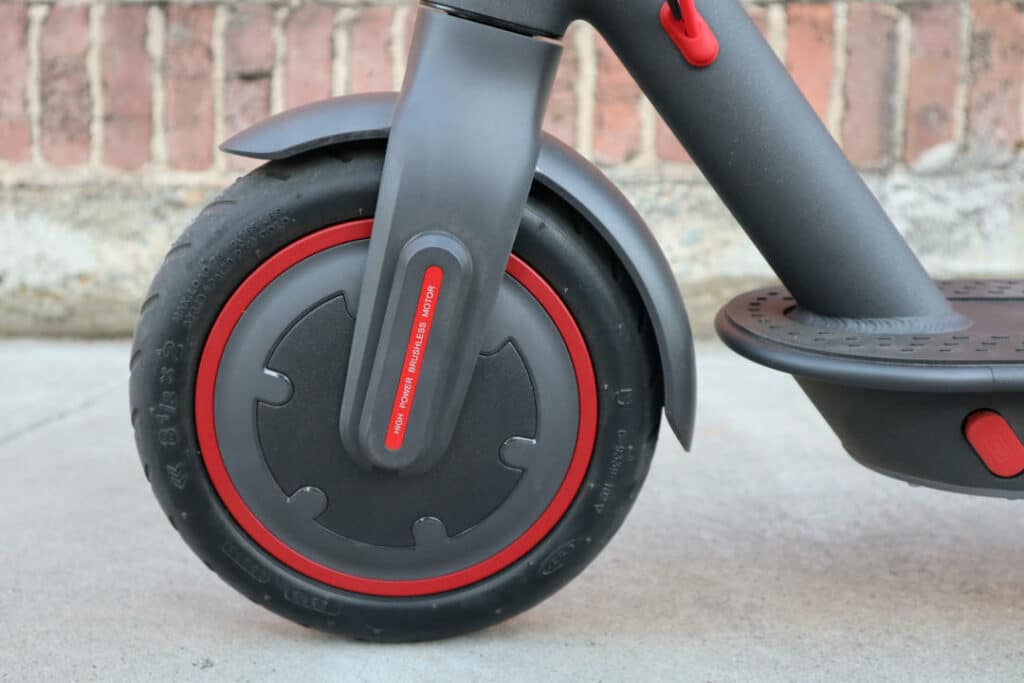

+ 9 More
Air 2022Air 2023
Xiaomi M365 Pro Summary
In this updated Xiaomi M365 Pro review, we'll show you why this entry-level scooter maintains its position as one of the best in the world (when you can get your hands on it). As an update to the template for all electric scooters, the Xiaomi M365, the Pro is slightly larger, a bit heavier, and packs 70% more range with a larger motor.
Compare the Xiaomi M365 and M365 Pro.
Sadly, the Xiaomi Mi M365 Pro is no longer available in 2023 in North America. But never fear! See our Editor's Choice list of Best Xiaomi Mi M365 Alternatives here!
Compare the Xiaomi M365 and M365 Pro.
Sadly, the Xiaomi Mi M365 Pro is no longer available in 2023 in North America. But never fear! See our Editor's Choice list of Best Xiaomi Mi M365 Alternatives here!

PROS
Exceptional real-world range
Solid upgrades to sturdy design
Decent power
Good quality

CONS
Not available in all locations
Technical Specifications
Tested Top Speed:
25.7 km/h**
Water Resistance:
IP54**
Max Rider Weight:
100 kg**
Weight:
14.1 kg**
Tested Range:
40.4 km**
Acceleration:
5.3 s**
**Based on our independent performance tests which may differ from manufacturer’s claims.
The Xiaomi M365 Pro is available in United Kingdom from Amazon (UK).
Our content is independent, but using our links supports our hard work!
Our Take: The Pro Is That Much Better Than the M365

As the sequel to the world's most popular entry-level scooter, the Xiaomi M365 Pro, also called the Mijia Pro, had a lot to live up to when it arrived in the market. Could Xiaomi really improve on their award-winning model known for satisfying all of a rider's basic needs?
Whatever small improvements could be made were, including upping the deck size, adding a more sophisticated display, and improving its overall performance. The M365 Pro delivers a remarkable - range in our tests, nearly 16.09 km more than its predecessor. The more powerful motor resulted in a quicker 0 to 9.32 km/h acceleration time of -, a full second faster than the M365 and a hair faster than the ever-popular stalwart, Segway Ninebot Max.
Whatever small improvements could be made were, including upping the deck size, adding a more sophisticated display, and improving its overall performance. The M365 Pro delivers a remarkable - range in our tests, nearly 16.09 km more than its predecessor. The more powerful motor resulted in a quicker 0 to 9.32 km/h acceleration time of -, a full second faster than the M365 and a hair faster than the ever-popular stalwart, Segway Ninebot Max.
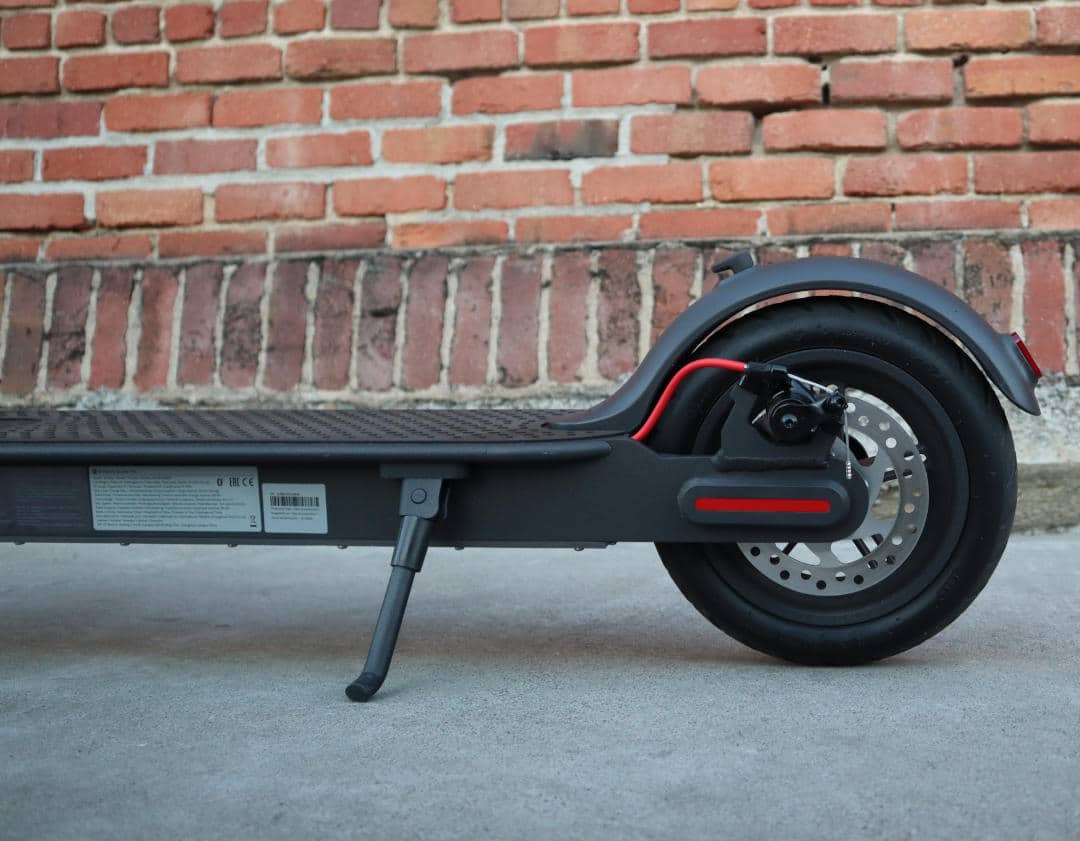
The features that already made the M365 a solid standout in its category can also be found on the Pro, including a comfortable thumb throttle, sturdy folding mechanism that keeps wobble at bay, a durable yet lightweight frame, air-filled tires to cushion the ride, and an effective dual braking system, with a front regenerative brake and rear disc brake. Now with an improved display providing all the details riders are looking for, the Pro fulfills riders needs really well, and at a budget.
The 2.27 kg difference between the Xiaomi Pro and M365 is significant when you consider it calculates to a 16% increase in weight, but the weight and cost are worthy trade-offs given that you're getting a longer deck, better display, and nearly double the range. When it comes to value in range per pound and acceleration per dollar, you can't do much better than the Xiaomi Pro.
The 2.27 kg difference between the Xiaomi Pro and M365 is significant when you consider it calculates to a 16% increase in weight, but the weight and cost are worthy trade-offs given that you're getting a longer deck, better display, and nearly double the range. When it comes to value in range per pound and acceleration per dollar, you can't do much better than the Xiaomi Pro.
Xiaomi M365 Pro Review
Acceleration
For its size and motor power, it has an effective launch, getting up to 9.32 km/h from a standstill in just 5.3 seconds. This is faster than the Xiaomi M365 (base).
Like many other entry-level scooters, the M365 Pro is a kick-to-start scooter, meaning you have to manually kick-push it up to at least 1.24 km/h before you can engage the throttle. Some entry-level scooters can be switched to zero-start, which means the throttle will automatically engage when you press it.
The start styles allow riders who have less experience to ease into acceleration, first having to kick the scooter up to speed before being able to throttle, while zero start gives riders the control to zip away from a full stop. Kick-to-start is also a good safety feature, as the scooter won't run away from you if you accidentally hit the throttle.
You can compare the performance of the Pro with others we've reviewed on our performance page.
Like many other entry-level scooters, the M365 Pro is a kick-to-start scooter, meaning you have to manually kick-push it up to at least 1.24 km/h before you can engage the throttle. Some entry-level scooters can be switched to zero-start, which means the throttle will automatically engage when you press it.
The start styles allow riders who have less experience to ease into acceleration, first having to kick the scooter up to speed before being able to throttle, while zero start gives riders the control to zip away from a full stop. Kick-to-start is also a good safety feature, as the scooter won't run away from you if you accidentally hit the throttle.
You can compare the performance of the Pro with others we've reviewed on our performance page.
Hill Climb
The M365 Pro has better hill climbing than quite a few other entry-level scooters, including the original M365, the TurboAnt X7 Pro, Segway Ninebot Max, and Gotrax G4. The Pro has an RG certified 15.6 second hill-climb time up our standard 60.96 m, 10% average grade incline with a 74.84 kg rider. It maintained an average speed of 5.41 km/h, which is a bit faster than the Segway Ninebot Max (which is 4.99 kg heavier with a slightly larger battery).
After over a year testing other scooters, the Pro remains a stronger hill climber than every scooter under £420. It’s also within striking distance of the more powerful Fluid FreeRide Horizon electric scooter, which is only 0.12 km/h faster uphill. While very steep hills will slow down the Pro, you'll have enough power to go up most hills.
After over a year testing other scooters, the Pro remains a stronger hill climber than every scooter under £420. It’s also within striking distance of the more powerful Fluid FreeRide Horizon electric scooter, which is only 0.12 km/h faster uphill. While very steep hills will slow down the Pro, you'll have enough power to go up most hills.
Top Speed
The Xiaomi Pro is capped to a max speed of -, but you can get to a reported 12.43 km/h by performing a firmware hack to unlock the Pro to a higher top speed.
Range
The Xiaomi Pro has an incredible 40.39 km of RG certified range thanks to a 300 watt lithium-ion battery.
Considering its meager - weight, the M365 Pro still has the best range per pound of any scooter that we’ve tested so far.
We perform all range tests in the scooter's highest performance mode on the same urban track, which has many stops, hills, and rough terrain. The ride is designed to simulate a real, fast urban commute.
Considering its meager - weight, the M365 Pro still has the best range per pound of any scooter that we’ve tested so far.
We perform all range tests in the scooter's highest performance mode on the same urban track, which has many stops, hills, and rough terrain. The ride is designed to simulate a real, fast urban commute.
Braking

The scooter has a dual braking system consisting of a front regenerative brake and a rear mechanical disc brake. Both brakes are linked and controlled by a single brake lever. In our braking test, the Xiaomi Pro came to a full stop from 9.32 km/h in just 4.66 m — a good result.
Despite being cable-controlled, brake activation is smooth due to well-designed, nicely routed cables. You can adjust the strength of the regenerative brake through the Bluetooth-enabled app. Keep in mind that the regen braking strength is substantial when in the maximum setting.
Despite being cable-controlled, brake activation is smooth due to well-designed, nicely routed cables. You can adjust the strength of the regenerative brake through the Bluetooth-enabled app. Keep in mind that the regen braking strength is substantial when in the maximum setting.
Ride Quality

The Xiaomi Pro is a nimble scooter thanks to its combination of reasonable weight, pneumatic tires, and geometry.
Carving on the Pro’s 5.08 cm-wide tires feels natural. They have enough size and grip to keep you confidently in control, and they conform better to the road than solid tires. The deck is 3.81 cm longer and 0.51 cm wider than the original. Although this doesn't seem like much, the Pro's deck width adds 12.5 sq in of standing room to the M365.
The handlebars are the same width, but are 3.56 cm higher than the handlebars on the M365. This change is pretty minimal, and may not make too much of a difference for the ride, but ensures the handlebars latch to the fender (which is now a little further away).
Despite lack of an integrated suspension, the large 21.59 cm pneumatic tires give it decent ride quality. On pavement — even in rough patches — the tires soak up much of the punishing road vibrations. If you encounter large potholes or steps, you'll definitely feel it but the Pro's tires will absorb some of the sting. If you’re consistently riding on really terrible roads, you’ll probably want to look at scooters with dedicated suspensions or at least larger tires.
Carving on the Pro’s 5.08 cm-wide tires feels natural. They have enough size and grip to keep you confidently in control, and they conform better to the road than solid tires. The deck is 3.81 cm longer and 0.51 cm wider than the original. Although this doesn't seem like much, the Pro's deck width adds 12.5 sq in of standing room to the M365.
The handlebars are the same width, but are 3.56 cm higher than the handlebars on the M365. This change is pretty minimal, and may not make too much of a difference for the ride, but ensures the handlebars latch to the fender (which is now a little further away).
Despite lack of an integrated suspension, the large 21.59 cm pneumatic tires give it decent ride quality. On pavement — even in rough patches — the tires soak up much of the punishing road vibrations. If you encounter large potholes or steps, you'll definitely feel it but the Pro's tires will absorb some of the sting. If you’re consistently riding on really terrible roads, you’ll probably want to look at scooters with dedicated suspensions or at least larger tires.
Xiaomi M365 Pro Features
Portability
The Xiaomi Pro has solid portability, weighs in at 14.06 kg and folds into a compact 111.76 cm long by 43.18 cm wide by 48.26 cm package — only 5.08 cm longer than the M365. It does not have folding handlebars, but does fold down (as do most electric scooters that we encounter).
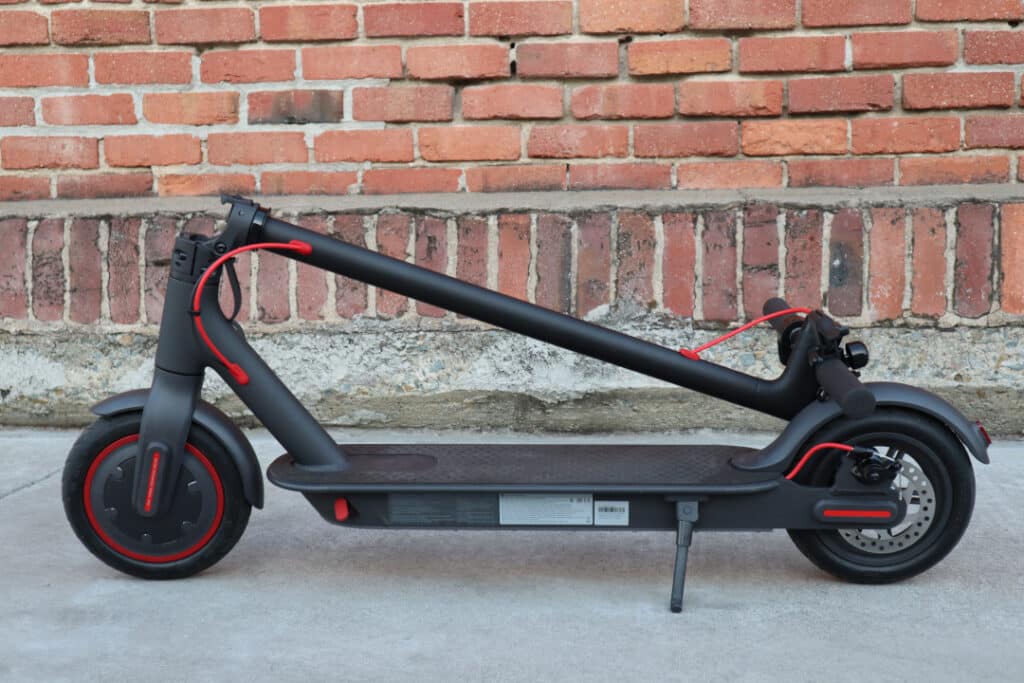
The folding mechanism, which has presented issues for some riders, allowing for stem flex with forward pressure, is identical on both the M365 and Pro. It has a lever that locks the stem into place, which is further secured by a rotating safety collar.
The collar prevents the lever from accidentally being pulled while riding. It's a good design, but not quite as solid as the similarly designed mechanism on the Segway Ninebot Max. The mechanism is quick to release and lock into place, which is a bit more commuter-friendly than the swingarm collar-style folding mechanisms found on most high performance scooters.
When folded, the stem locks to the rear fender for easy carrying. Some of these mechanisms take a bit of practice to aim the latch on the handlebars to the hook on the fender, but folding on the Pro feels very natural.
Overall, the Pro has good portability, but isn't quite as compact as an ultraportable (it would need to have folding handlebars).
The collar prevents the lever from accidentally being pulled while riding. It's a good design, but not quite as solid as the similarly designed mechanism on the Segway Ninebot Max. The mechanism is quick to release and lock into place, which is a bit more commuter-friendly than the swingarm collar-style folding mechanisms found on most high performance scooters.
When folded, the stem locks to the rear fender for easy carrying. Some of these mechanisms take a bit of practice to aim the latch on the handlebars to the hook on the fender, but folding on the Pro feels very natural.
Overall, the Pro has good portability, but isn't quite as compact as an ultraportable (it would need to have folding handlebars).
Cockpit
The Xiaomi Pro cockpit looks very similar to the Xiaomi M365, but it has more features by far. Centered on the stem is the LED dashboard, which is a welcome upgrade providing details including your speed, battery level, and riding mode. The display screen is bright and will also show you if Bluetooth is connected and if the lights are on.
You use one button to change modes, switch lights on and off, and power, and can also access rider features through the Xiaomi or other third party mobile apps, including regenerative braking strength and display units (metric or imperial).
The Pro has three riding modes, which limit top speed to 5.59 km/h (eco), 7.46 km/h (standard), and 9.94 km/h (sport), represented on the screen by a small letter beneath your speedometer. One nice feature is the screen's backlighting is adaptive, dimming when the ambient light has darkened. This is a nice feature for night riding, as it keeps the display from blinding you.
The cockpit of the Xiaomi Pro is clean, simplistic with rounded, texturized hand grips that feel like a good quality rubber. On the left handlebar, you'll find the brake lever and mechanical bell, with the folding hook doubling as the bell's hammer (such a smart design!). On the right handlebar, there's the thumb throttle with a rubberized pad, and that's it.
The Pro has three riding modes, which limit top speed to 5.59 km/h (eco), 7.46 km/h (standard), and 9.94 km/h (sport), represented on the screen by a small letter beneath your speedometer. One nice feature is the screen's backlighting is adaptive, dimming when the ambient light has darkened. This is a nice feature for night riding, as it keeps the display from blinding you.
The cockpit of the Xiaomi Pro is clean, simplistic with rounded, texturized hand grips that feel like a good quality rubber. On the left handlebar, you'll find the brake lever and mechanical bell, with the folding hook doubling as the bell's hammer (such a smart design!). On the right handlebar, there's the thumb throttle with a rubberized pad, and that's it.

Although its features may not seem premium, it is worth noting that both the throttle and brake lever feel solid and top notch. The mechanical action of the aluminum brake lever is crisp. The lever is wide and feels good on your fingertips, and the lack of extra stuff on the handlebars grants you space to add your own accessories.
The Xiaomi Pro is Bluetooth-enabled and can be paired with a smartphone app like the Xiaomi home app or one of many third party apps. Considering the upgraded display on the Pro provides more details, there's less reason to use the app, but it does provide scooter health information and allows you to set the regenerative braking strength.
The Xiaomi Pro is Bluetooth-enabled and can be paired with a smartphone app like the Xiaomi home app or one of many third party apps. Considering the upgraded display on the Pro provides more details, there's less reason to use the app, but it does provide scooter health information and allows you to set the regenerative braking strength.

Lights
The Pro has a handlebar-height LED headlight and rear taillight that responds to braking. The high-mounted headlight is an appreciated feature that projects light further ahead, improving visibility for you and for others to see you.

Keep in mind that neither light is particularly bright, so you will need additional, brighter lighting, especially when riding at night. We recommend these ultra-bright lights.
Tires
The Pro has dual 21.59 cm by 5.08 cm pneumatic (air-filled) inner tube tires. The supple rubber provides the best performance in wet conditions while the air helps to cushion your ride, unlike solid tires which do not conform to the road.

Although you cannot get flats on solid tires, air-filled tires provide a much more comfortable ride. We got a flat while testing the Pro, but most flats can be prevented or repaired with tire slime.
Deck
The rubberized deck is a good size and covered in nubs for added traction. It is 5.08 cm longer than the M365 but a relatively average sized deck for an entry-level scooter. The charging port is on the front left corner of the deck, and enclosed with a magnetized rubber cover. That's a nice, minor upgrade from the M365, which did not have a magnetized port cover.

Build Quality
Whereas the high-performance beast scooters we love to review are manufactured on a smaller scale, leading to variations in quality, the Pro is mass produced and benefits from streamlined production. In addition to looking well sealed, it carries a water resistance IP rating of IP54, meaning that it can tolerate water splashes (keep in mind the warranty doesn't cover water damage).
The overall assembly, fit and finish, packaging, and quality are excellent. This is reflected in parts that feel tightly assembled and mechanicals that move smoothly. Surfaces are nicely finished, and all materials have a cohesive feel together.
However, it’s made of lighter weight material than other scooters, and feels less durable for long-term use than the hand-assembled beast scooters. For example, numerous riders have had issues with a faulty aluminum tab in the folding mechanism that would fracture on older models from repeated folding. This issue has been remedied in later models, but is a symptom of lighter constructed scooters.
The Xiaomi Pro feels solid, complete and well-made, and is an awesome value for its performance, but may not be able to withstand years of abuse.
However, it’s made of lighter weight material than other scooters, and feels less durable for long-term use than the hand-assembled beast scooters. For example, numerous riders have had issues with a faulty aluminum tab in the folding mechanism that would fracture on older models from repeated folding. This issue has been remedied in later models, but is a symptom of lighter constructed scooters.
The Xiaomi Pro feels solid, complete and well-made, and is an awesome value for its performance, but may not be able to withstand years of abuse.
Conclusions
The Xiaomi M365 Pro is a standout scooter for its amazing value, in both range per pound and acceleration per dollar. Among all of the other entry-level options out there, the Pro is like flying economy plus. You feel like you’re getting more, but you’re also not completely sure.
It’s got a very basic look, simple display, easy operation, and entry-level price, but keep in mind it’s the bigger brother of the scooter known around the world, and is a real improvement to the original. With a larger battery capacity, longer range, and better hill climbing ability, the Pro is a definite upgrade to the M365 and bests most other entry-level scooters in the market.
What makes the M365 Pro a bit of a disappointment is that it isn’t widely available, as it is frequently out of stock or not available for sale in the United States and some other locations.
It’s got a very basic look, simple display, easy operation, and entry-level price, but keep in mind it’s the bigger brother of the scooter known around the world, and is a real improvement to the original. With a larger battery capacity, longer range, and better hill climbing ability, the Pro is a definite upgrade to the M365 and bests most other entry-level scooters in the market.
What makes the M365 Pro a bit of a disappointment is that it isn’t widely available, as it is frequently out of stock or not available for sale in the United States and some other locations.
Comparisons
Upgrade from M365 to M365 Pro
If you already own an M365, should you upgrade to the Pro? If you need the extra range or a bit more oomph, definitely. If you’re satisfied with the M365 already, then the modest improvements aren’t worth it.
Sadly, the Xiaomi Mi M365 Pro is no longer available in 2023. But never fear! See our Editor's Choice list of Best Xiaomi Mi M365 Alternatives here!
Technical Specs Comparison

Model
Xiaomi M365 Pro
Fluid Freeride Horizon
Segway Ninebot Max
Xiaomi Mi M365

Top Speed**
25.7 km/h
38.6 km/h
29.6 km/h
26.9 km/h

Range**
40.4 km
41.8 km
34.8 km
23.5 km

Weight**
14.1 kg
17.5 kg
19.7 kg
12.3 kg

Price
$599
£799
£639
£405
**Based on our independent performance tests which may differ from manufacturer’s claims.
Related Reviews

Our newsletter has the biggest discounts, newest scooter reviews, best how-to’s, & no spam. Unsubscribe anytime!
Find your perfect ride
We built a tool that makes it effortless for you to find a scooter perfect for your lifestyle. Filter, compare, and sort through almost every electric scooter in the industry.
jump injump in

